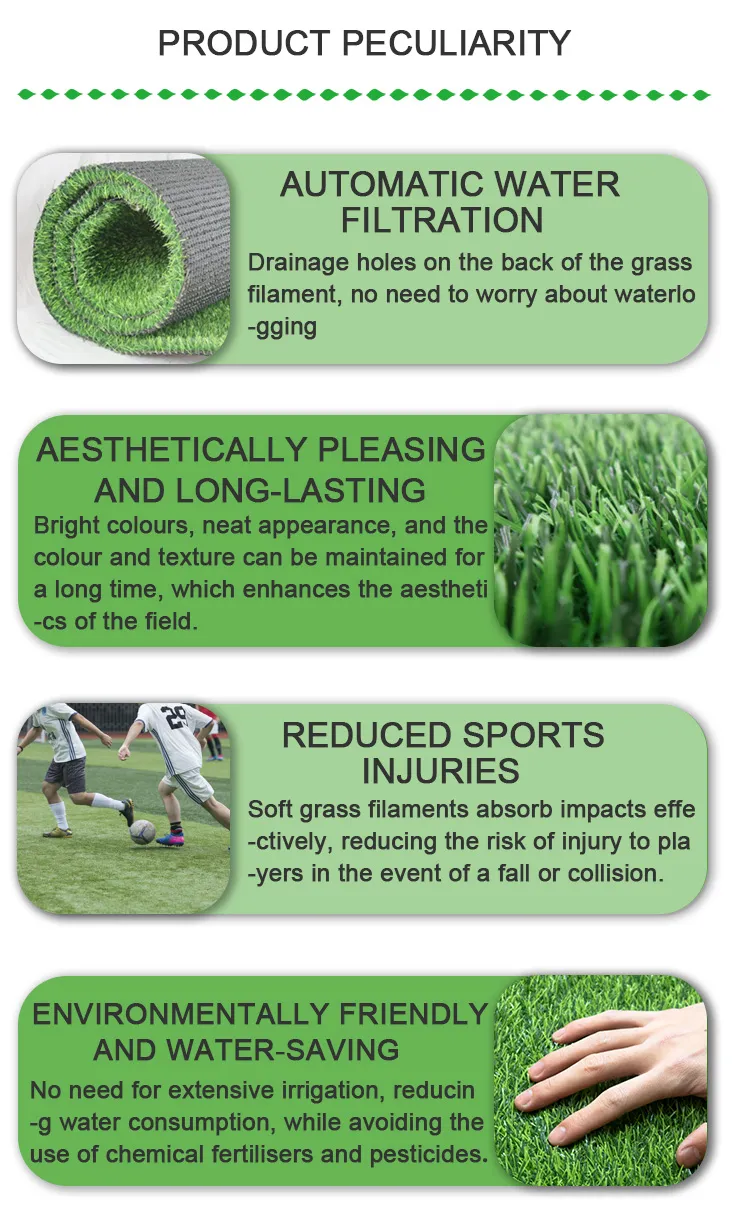
- Afrikaans
- Arabic
- Belarusian
- Bengali
- Czech
- Danish
- Dutch
- English
- Esperanto
- Estonian
- Finnish
- French
- German
- Greek
- Hindi
- Hungarian
- Icelandic
- Indonesian
- irish
- Italian
- Japanese
- kazakh
- Rwandese
- Korean
- Kyrgyz
- Lao
- Latin
- Latvian
- Malay
- Mongolian
- Myanmar
- Norwegian
- Persian
- Polish
- Portuguese
- Romanian
- Russian
- Serbian
- Spanish
- Swedish
- Tagalog
- Tajik
- Thai
- Turkish
- Turkmen
- Ukrainian
- Urdu
- Uighur
- Uzbek
- Vietnamese
laying artificial turf on soil
Dec . 20, 2024 04:59 Back to list
Laying Artificial Turf on Soil A Comprehensive Guide
Artificial turf has become an increasingly popular choice for homeowners and businesses seeking a low-maintenance, aesthetically pleasing alternative to natural grass. The process of laying artificial turf on soil may seem overwhelming at first, but with proper preparation and execution, it can be a rewarding DIY project. This article will guide you through the essential steps to successfully install artificial turf on soil.
Understanding the Benefits of Artificial Turf
Before delving into the installation process, it’s essential to understand why many people choose artificial turf. One of the significant advantages is its low maintenance requirement. Unlike natural grass, synthetic turf doesn’t need to be watered, mowed, or fertilized, which saves both time and money. Additionally, it remains lush and green year-round, resisting fading from UV exposure and minimizing wear and tear from foot traffic. It also provides a soft, safe surface for children and pets to play on.
Preparing the Installation Site
The first step in laying artificial turf is site preparation. Start by clearing the area of any existing grass, weeds, rocks, or debris. This can be achieved by using a shovel, rake, or sod cutter, ensuring you have a level surface. Once cleared, it’s crucial to assess the soil condition. If you have soft, sandy soil, it might hold moisture well, but in areas with clay or excessively hard soil, water drainage can become a problem.
Next, compact the soil using a soil compactor or simply by walking over it to create a firm base. Ideally, the surface should slope away from buildings to prevent water accumulation. You may also want to lay down a geotextile fabric over the compacted soil to prevent weed growth and promote drainage.
Installing a Base Layer
To create a suitable base for the artificial turf, adding a layer of crushed stone or decomposed granite is recommended. This layer should be approximately 1-4 inches thick, depending on how soft or unstable the soil is. Use a rake to spread the material evenly, then compact it to form a stable foundation. This base will aid in drainage and contribute to the longevity of your turf.
laying artificial turf on soil

Laying the Artificial Turf
Now that your base is prepared, it’s time to lay the artificial turf. Unroll the turf and lay it on the prepared base, allowing for a slight overhang on the edges. If your installation involves multiple pieces, make sure the blades of the grass are all facing the same direction for a consistent and natural look.
Once the turf is positioned, cut it to fit the area using a sharp utility knife. Make precise cuts, especially around curves and edges, to ensure a clean finish. When working with seams between different pieces of turf, overlap the edges slightly, and then trim them to align perfectly. For larger areas, it’s a good idea to use adhesive or seam tape, following the manufacturer’s instructions for securing the pieces together.
Securing the Turf
After aligning and cutting the turf, the next step is anchoring it securely to the ground. Using landscape staples or nails, fasten the edges of the turf to the base. Be sure to place the fasteners every few inches along the perimeter and seams, ensuring it stays in place and reducing the risk of shifting over time.
Adding Infill and Grooming
Finally, depending on your artificial turf type, you may need to add an infill material—typically composed of rubber granules or sand. This infill helps the grass blades stand upright, protects them, and provides added cushioning. After spreading the infill evenly across the surface, use a broom or a power-brushing tool to ensure the infill settles well and the grass fibers stand tall.
Conclusion
Laying artificial turf on soil can transform any area into a well-maintained, vibrant space. By carefully preparing your site, installing a proper base, and following the steps to lay and secure the turf, you can enjoy the benefits of synthetic grass for years to come. Whether for a backyard, sports field, or commercial space, artificial turf offers a solution that combines beauty and functionality with minimal upkeep. With patience and attention to detail, anyone can achieve professional-quality results in their installation project.
-
The Benefits of Artificial Turf for Indoors
NewsJul.15,2025
-
How Artificial Grass Suppliers Ensure Quality Products
NewsJul.15,2025
-
Artificial Grass and Pets: A Space for Relaxation
NewsJul.08,2025
-
Balcony & Outdoor Decoration with Artificial Grass
NewsJul.08,2025
-
Best Indoor Artificial Grass for Home
NewsJul.07,2025
-
Best Pet Turf for Dogs: Safe & Durable Artificial Grass Options
NewsJul.07,2025
Products categories









